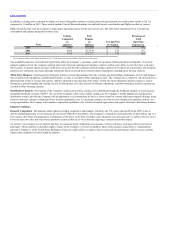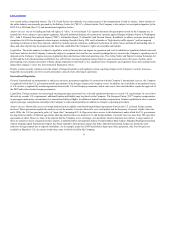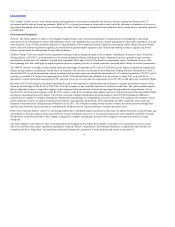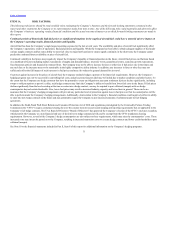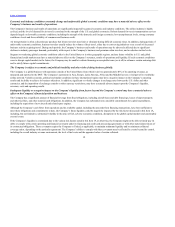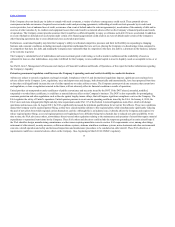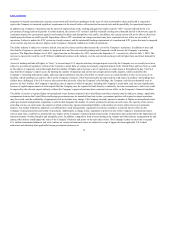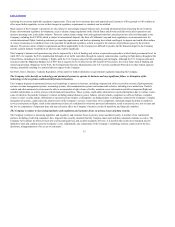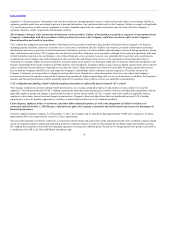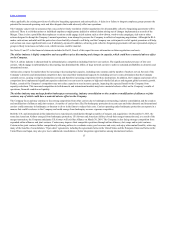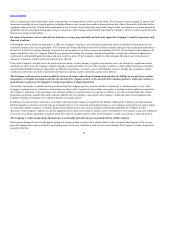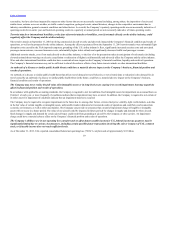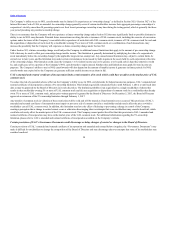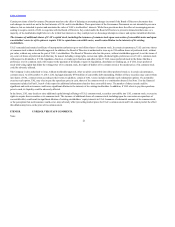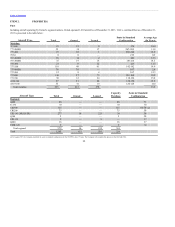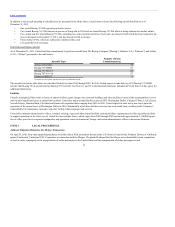United Airlines 2013 Annual Report Download - page 13
Download and view the complete annual report
Please find page 13 of the 2013 United Airlines annual report below. You can navigate through the pages in the report by either clicking on the pages listed below, or by using the keyword search tool below to find specific information within the annual report.
Table of Contents
If the Company does not timely pay its debts or comply with such covenants, a variety of adverse consequences could result. These potential adverse
consequences include an increase of required reserves under credit card processing agreements, withholding of credit card sale proceeds by its credit card
service providers, loss of undrawn lines of credit, occurrence of an event of default under the relevant agreement(s), acceleration of the maturity of debt and/or
exercise of other remedies by its creditors and equipment lessors that could result in a material adverse effect on the Company’s financial position and results
of operations. The Company cannot provide assurance that it would have sufficient liquidity to repay or refinance such debt if it were accelerated. In addition,
an event of default or declaration of acceleration under certain of its financing agreements could result in an event of default under certain of the Company’s
other financing agreements due to cross default and cross acceleration provisions.
Furthermore, constrained liquidity may limit the Company’s ability to withstand competitive pressures and limit its flexibility in responding to changing
business and economic conditions, including increased competition and demand for new services, placing the Company at a disadvantage when compared to
its competitors that have less debt, and making the Company more vulnerable than its competitors who have less debt to a downturn in the business, industry
or the economy in general.
The Company’s substantial level of indebtedness and non-investment grade credit rating, as well as market conditions and the availability of assets as
collateral for loans or other indebtedness, may make it difficult for the Company to raise additional capital to meet its liquidity needs on acceptable terms, or at
all.
See Part II, Item 7, Management’s Discussion and Analysis of Financial Condition and Results of Operations, of this report for further information regarding
the Company’s liquidity.
Extensive government regulation could increase the Company’s operating costs and restrict its ability to conduct its business.
Airlines are subject to extensive regulatory and legal oversight. Compliance with U.S. and international regulations imposes significant costs and may have
adverse effects on the Company. Laws, regulations, taxes and airport rates and charges, both domestically and internationally, have been proposed from time
to time that could significantly increase the cost of airline operations or reduce airline revenue. The Company cannot provide any assurance that current laws
and regulations, or laws or regulations enacted in the future, will not adversely affect its financial condition or results of operations.
United provides air transportation under certificates of public convenience and necessity issued by the DOT. If the DOT altered, amended, modified,
suspended or revoked these certificates, it could have a material adverse effect on the Company’s business. The DOT is also responsible for promulgating
consumer protection and other regulations such as the rule against lengthy tarmac delays, that will impose significant compliance costs on the Company. The
FAA regulates the safety of United’s operations. United operates pursuant to an air carrier operating certificate issued by the FAA. On January 4, 2014, the
FAA’s new and more stringent pilot flight and duty time requirements under Part 117 of the Federal Aviation Regulations took effect, which will disrupt
operations and increase costs. In August 2013, the FAA significantly increased the minimum qualifications for air carrier first officers. These new regulations
impact the Company and its regional partner flying, as they have caused mainline airlines to hire regional pilots, while simultaneously significantly reducing
the pool of new pilots from which regional carriers themselves can hire. Although this is an industry issue, it directly affects the Company and requires it to
reduce regional partner flying, as several regional partners are beginning to have difficulty flying their schedules due to reduced new pilot availability. From
time to time, the FAA also issues orders, airworthiness directives and other regulations relating to the maintenance and operation of aircraft that require material
expenditures or operational restrictions by the Company. These FAA orders and directives could include the temporary grounding of an entire aircraft type if
the FAA identifies design, manufacturing, maintenance or other issues requiring immediate corrective action. FAA requirements cover, among other things,
retirement of older aircraft, security measures, collision avoidance systems, airborne windshear avoidance systems, noise abatement and other environmental
concerns, aircraft operation and safety and increased inspections and maintenance procedures to be conducted on older aircraft. These FAA directives or
requirements could have a material adverse effect on the Company. Also, beginning in March 2014, OSHA’s regulatory
13





